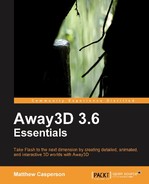We have seen how 3D objects can be created and displayed within the scene, and until now they have been displayed using the default material, WireColorMaterial, which displays as a solid color with black outline. While this does allow us to view our 3D objects, it is a little boring. Thankfully, Away3D includes over a dozen material types that can be used to display 3D objects with a huge variety of effects, with some of the materials using the Pixel Bender technology new to Flash Player 10 to create a level of detail that has not previously been seen in Flash applications.
This chapter covers the following:
- Managing resources by embedding them, or loading them from external files
- Defining colors
- Pixel Bender
- The various shading techniques used by Away3D materials
- The different materials that can be created in Away3D
- Illuminating materials with lights
Throughout this chapter, a number of references will be made to materials and textures. A texture is simply an image, like you would create in an image editing application like Photoshop or view in a web page. Textures are then used by materials, which in Away3D are classes that can be applied to the surface of a 3D object.
